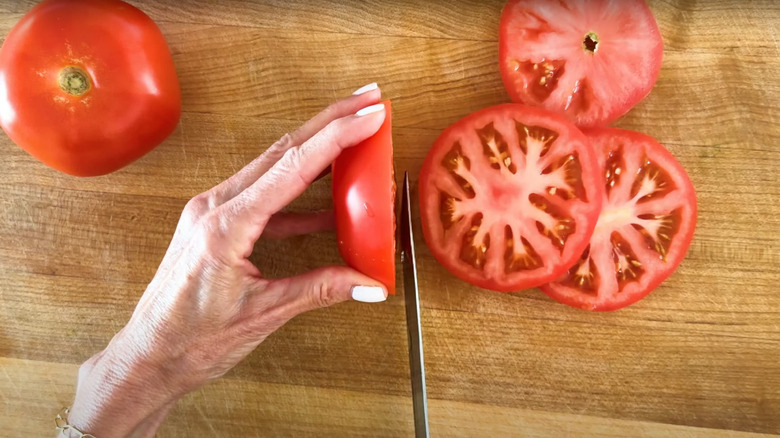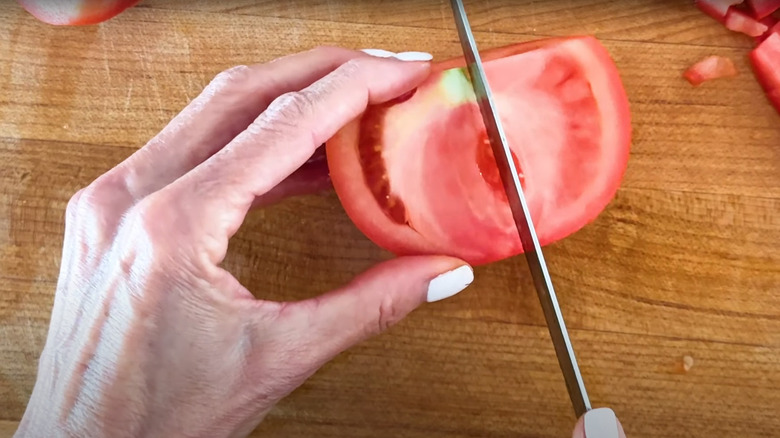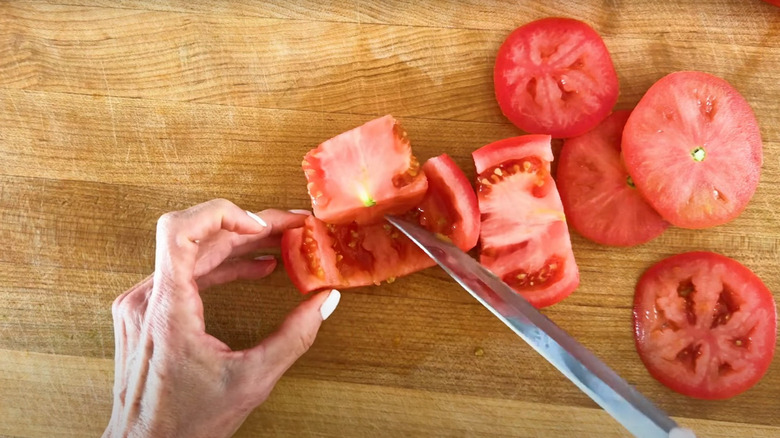Here's Why You Can Never Seem To Cut A Tomato Properly
Have you ever attempted to slice and dice a bunch of tomatoes for a recipe and ended up with a big pulpy mess? Chowhound recipe developer Miriam Hahn felt your pain and pulled together some tips and tricks to make sure that the next time you make a summery smoked mozzarella caprese salad or fresh tomato bruschetta with basil, you can do so with confidence.
First, the texture of the tomato matters. When you want cleanly sliced, diced, and wedged tomatoes, go for varieties such as plum (also known as roma), beefsteak, and even grape tomatoes that have taught skin and a firm feel. Save softer fruits for sauteing down for a pasta sauce or blending into the broth in a sopa de fideo recipe.
If you bought heirloom tomatoes from the farmers market or grew them yourself, you can probably tell that they are also too soft to easily cut into a fine dice. Attempting to do so will probably result in a cutting board full of mealy liquid. These varieties of tomatoes have not been engineered to withstand commercial packing and distribution, so they are very delicate and have lots of juice. Use these for preparations like sandwiches and platter salads that do not require the tomato to be handled much. Heirloom tomatoes are also great candidates for blending into something like José Andrés' favorite gazpacho, so you can avoid the fuss of cutting them all together.
A dull knife and fresh tomatoes should never meet
When you use a dull knife to attempt to cut tomatoes, you end up pressing into the skin rather than slicing through. That is why Miriam Hahn recommended a sharp, serrated knife for this purpose instead. The teeth of the knife provide traction on the slippery skin, so you can easily cut through with a sawing motion. A dull straight-edge blade requires you to push down too hard, bruising and mashing the fruit instead of creating clean cuts. If you have an exceptionally sharp straight-edge knife, Hahn does say that these sorts of blades will also do the trick, but a serrated knife is her go-to.
For slices, turn the tomato on its side, and use your non-dominant hand to balance it while your dominant hand slices from one side to the other, parallel to the equator. With a serrated knife, you can make picture-perfect slices that stay perfectly round without forcing the juicy insides to spew out.
Do not cut out the core, especially when cutting wedges
You know that woody looking circle where the stem once connected to the fruit? Fight temptation and just leave it be. "Another common mistake people make is cutting this core out, but the core is what holds the whole tomato together," Miriam Hahn explained (via YouTube). If you find the core to be unsightly, trim it only after you have cut the tomato into pieces.
The dense flesh that runs from pole to pole can also act as a guide when you want to cut tomato wedges for hearty dishes like a classic Cobb or Ree Drummond's layered salad. Trim off a thin slice from the top to create a flat surface, and flip the tomato so it is standing firmly up right. Then, cut the tomato into two halves. Run your knife along the core, halving each piece into wedges and repeating to make as many segments as you like.
The seeds and pulp have got to go when dicing
Cutting tomatoes into strips or a fine dice can be very cumbersome when your cutting board gets totally saturated with juice, seeds, and pulp. That is why it is best to remove them, though you can absolutely save the discarded portion to toss into sauces, soups, beans, stock, or blended salad dressings.
To leave just the firm flesh behind, start by slicing off the top and bottom of the tomato, standing it up, and then slicing the whole fruit in half. Then, run the knife all the way along the bottom edge of each half to cut out the entire pulpy center. Any seeds that are left behind can be scooped out with a spoon. Now you are left with a tomato piece that looks a bit like the rind of a melon that can effortlessly be sliced into strips or diced. The seedless tomato pieces are perfect for meal-prepped grain bowls, slaws, salads, and salsas — because even after sitting, they will not get overly soggy or waterlogged.
Static Media owns and operates Food Republic and Chowhound.



